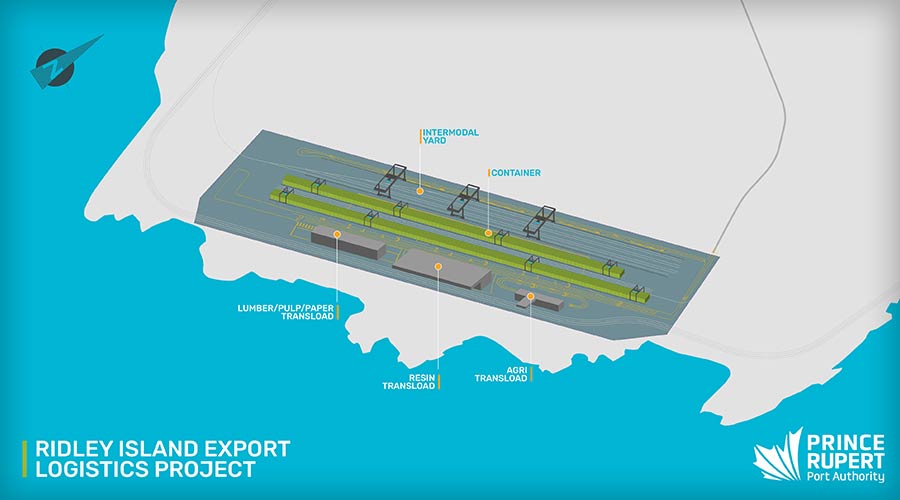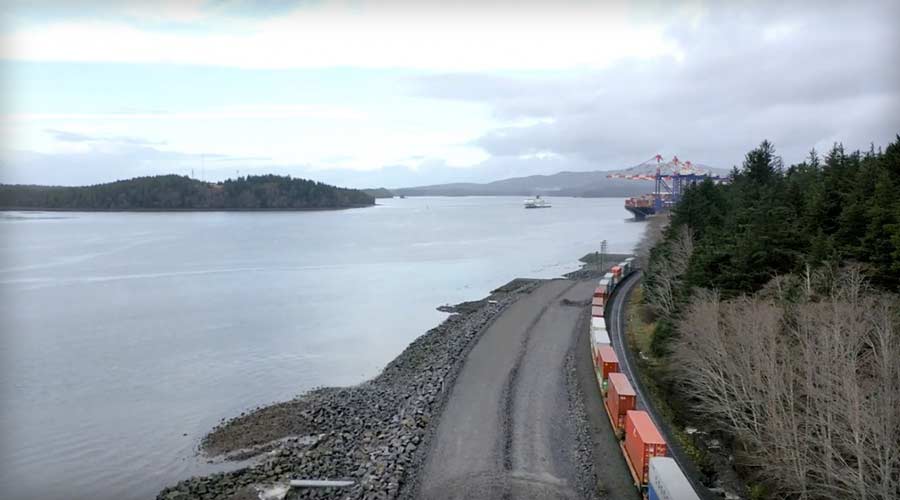British Columbia port advances long-planned, CN-served export complex
3/28/2023
By Jeff Stagl, Managing Editor
The Port of Prince Rupert, British Columbia, recently reached a critical milestone for a major project, and is approaching another one.
The Prince Rupert Port Authority (PRPA) in early March obtained a final environmental review for the Ridley Island Export Logistics Project (RIELP) from the Canadian federal government that determined the planned complex would not significantly impact the environment. The CA$300 million RIELP calls for constructing rail, road, land and utility infrastructure on the southern end of the island.
To be served solely by CN, the export complex will feature a 27-acre transload area for large-scale bulk and breakbulk freight, a 20-acre intermodal rail yard and a 23-acre container storage yard. The RIELP will be used to transload such commodities as plastic pellets, cereal grains, specialty agriculture crops, lumber and pulp.
 The Ridley Island Export Logistics Project will include a 27-acre transload area, 20-acre intermodal rail yard and 23-acre container storage yard. Prince Rupert Port Authority
The Ridley Island Export Logistics Project will include a 27-acre transload area, 20-acre intermodal rail yard and 23-acre container storage yard. Prince Rupert Port Authority The PRPA expects the transload area to accommodate up to three unit trains of dry bulk commodities and up to one-and-a-half unit trains of breakbulk cargo each day, and the intermodal yard to handle up to three unit trains at a time.
Under the project’s first phase, an additional 400,000 20-foot equivalent units of export cargo capacity will be created, authority officials say.
The PRPA manages Canada’s third-largest seaport as measured by container volume and cargo tonnage, trailing only the ports in Montreal and Vancouver. In addition to enhancing export capacity, the RIELP will enable Canadian exporters to move products to Prince Rupert by rail, authority officials say.
The rail infrastructure associated with the RIELP involves nearly 16 miles of track, including:
• three inbound loop tracks totaling about six miles;
• three outbound tracks totaling about six miles;
• three unloading tracks;
• lead tracks to connect the loop tracks to a causeway; and
• intermodal tracks split into six tracks (five stub tracks and one through track).
“The rail infrastructure is a core element of the project,” said Brian Friesen, the PRPA’s vice president of trade development and real estate, in an email. “It includes dedicated inbound and outbound loop tracks around the perimeter of Ridley Island, building off of the existing road, rail and utility corridor on Ridley Island.”
 Completed last year, the Fairview Ridley Connector Corridor is a private road that connects the port’s container terminal with the island. Prince Rupert Port Authority
Completed last year, the Fairview Ridley Connector Corridor is a private road that connects the port’s container terminal with the island. Prince Rupert Port Authority Authority officials consider some recent intermodal developments at the port to be advantageous for that corridor: DP World Prince Rupert Inc. expanded the CN-served Fairview Container Terminal; CN and the PRPA added two rail sidings south of the terminal; and the PRPA completed the Fairview Ridley Connector Corridor, a private road connecting the terminal with the island.
The RIELP is a vital component of the PRPA’s plan to fully integrate intermodal activities between terminals, logistics and rail. The project has been under development for a number of years, said Friesen.
The RIELP’s next — and perhaps last — milestone prior to construction? A final investment decision by the PRPA, which is anticipated in the next few months, said Friesen.
For now, early construction activities — such as tree and site clearing — began in early March. The RIELP is anticipated to be completed in 2025.


